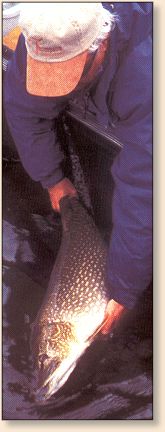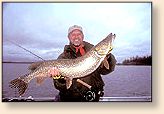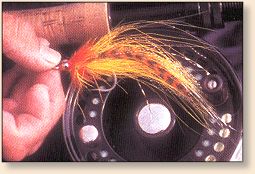The Big Girls of the Territories
By Scott Earl Smith
Standing in the bow of a boat cruising the flats
with a ten-weight rod in one hand and a bright
nge bucktail in the other, you might think I was
sight fishing the Keys or Belize. But quite to
the contrary, I was cruising the sandy,
flat-bottomed bays of Thekulthili Lake in the
Northwest Territories for giant northern pike in
early September. These are the voracious carnivores
of the north that feed in the depths and then retreat
to the shallows to rest and warm their bodies.
Northern pike are common virtually throughout North
America, but there are some select places in the most
northern reaches of Canada where they regularly grow
very big. Mostly these are clear-water trout lakes
that lack the bass, walleye and perch commonly found
in more southern latitudes. In these cold waters
pike are king of the shallows and have no other
species vying for forage base; hence they grow big
and very nasty. I was fortunate enough to tangle with
some of these on a trip to Thekulthili Lake in the NWT
late last summer.
My trip started out with a knockout punch. On our approach,
after a two-hour floatplane trip from Yellowknife, the
clear waters of Thekulthili looked like Shangri-La.
But it seemed as soon as the plane had left us on the
dock and slipped away through the puffy clouds and
blue sky, the ceiling dropped to a few hundred feet
and turned the day dark and drizzly. Knowing that
cold fronts are the "kiss of death" for most kinds
of fishing, most of our party kicked around camp,
foraging on groceries and looking longingly at the
sky for reprieve. Meanwhile, I took the opportunity
to try out a new imported fly rod that guide Neil Courtice,
our guide from Lady Grey Wilderness Outfitters, suggested
I cast off the dock. On my third cast I hooked something
solid that bolted for the depths. About ten minutes
later, Neil tailed the fish for me: a svelte pike of
forty inches.

"Great start," announced Neil. And, from there, the
trip only got better.
We never did see the sun for the remainder of our four
days at Thekulthili (at least not until our plane
arrived to shuttle us back to Yellowknife), but we
saw lots of big, mean pike with streamers hanging
from their lips. The plan of attack was to sleep
in, eat a breakfast that would make a cardiologist
cringe (or smile, depending on which way you looked
at it), and then hit the water. We cast blind over
a few deep weed beds on the main lake, but mostly
we glided through the many adjoining shallow bays
and hunted for resting fish on the sand flats;
concentrating on small patches of cabbage when
fish were not in plain view. Neil informed that
the biggest pike were always the females, and
henceforth refers to them as "Big Girls" - with
a certain playful but reverent endearment.
Neil's approach was a no-nonsense battle plan that
involved drifting or trolling through the shallows
with one angler strafing the cover and the other
scouring the open sand from the bow. We'd work a
bay for a half-hour or so, and if the Big Girls
weren't in, we'd fire up the outboard and set sail
for the next shallow bay. Neil explained that the
biggest pike fed in the depths and competed with
huge lake trout for whitefish. Middleweight pike,
say up to ten-pounds or so, would only end up in
the belly of a big laker if they followed suit.
The Big Girls then returned to the shallows for
a post-feed rest, but would still take a bright-coloured
streamer if the approach was made without error.
Neil briefed me on this approach in case we
encountered a truly big pike in the shallows:
"You don't cast right at them, Scott. If you
land a cast on their noses, they'll bolt the
other way. You cast about twenty-feet ahead of
them as they cruise. If they want your
fly - you'll know about it shortly." This, as
it turned out, was sage advice.

On our last day we trolled through a huge sand flat
nicely nestled between a few small islands - right
off the depths of a nearby feeding ground for pike
and lakers in the main lake. By this time I had
caught so many pike between two- and twenty-pounds
that I really didn't care to fool with them anymore.
I was holding out for big daddy - or to reflect more
appropriate scientific correctness, big momma. I
had tied up a handful of streamers the night before
under Neil's tutorage. His suggested pattern was
simply a bucktail a la Mickey Finn with a gold tinsel
body and a few strands of Crystal Flash for added
colour on a saltwater hook. The pattern was only
about three inches long, but, according to Neil,
that was all you really needed. The slate sky,
brisk breeze and incessant drizzle made spotting
fish a challenging affair - even in these pristine
conditions. Nevertheless, I stood like a heron in
the front of the boat: stock-still, stoic, patient,
and always hopeful. I told myself that many a trophy
has been taken on the last day of a good trip, and
I had about four hours to make good on that theory.
A short time later I spotted a large, olive-green
shape moving quickly from almost directly in front
of the bow. With line, rod and fly at the ready, I
snapped out a quick double-haul about forty feet
straight ahead and about twenty feet in front of
the fish as Neil had instructed. I gave the fly
two good strips before the shape struck like lighting.
As I set the hook, I felt that twisting power that
only a big fish can make. The fish surged across
the flats for the mouth of the bay. "Good one,
Neil. A Big Girl!" I shouted.
Neil started the engine and kept us out of the weeds
as I fought the big fish. At one point it swam
diagonally towards us and then buried itself in a
heavy clump of cabbage. Fortunately, Neil had
encouraged me to discard my 15-pound leader in
exchange for some 40-pound for exactly this reason.
I held my rod firm and let the line cut through
the weeds as the fish circled through and headed
once again for open water. Eventually, I brought
the fish portside where Neil tailed her and hoisted
her carefully above the boat. She was an exceptionally
thick and healthy fish that likely tipped the scales
around 24-pounds.
 Judging by the bulge in her stomach
she had recently consumed a fish of a size that most
fly anglers would be quite happy to catch. We snapped
a few pictures before watching her cruise away to finish
digesting. Although our trip was made at the tail end of
seasonable weather in the Territories, our timing coincided
with the healthiest time in the pike's annual cycle. They
were strong, aggressive and hungry - and tested my tackle
like nothing I'd ever experienced.
Judging by the bulge in her stomach
she had recently consumed a fish of a size that most
fly anglers would be quite happy to catch. We snapped
a few pictures before watching her cruise away to finish
digesting. Although our trip was made at the tail end of
seasonable weather in the Territories, our timing coincided
with the healthiest time in the pike's annual cycle. They
were strong, aggressive and hungry - and tested my tackle
like nothing I'd ever experienced.
Equipment
 Although an eight or nine weight rod will suffice, my
preference is a ten weight saltwater graphite in a three
or four-piece travel model. The stiffness of these rods
allows you to power fish and cast big flies for great
distances - even into the wind. On my trip I had two
rods at the ready: one loaded with a floating line and
a popper, and the other with a sinking head and a
streamer. Because of the conditions, the fish were
not responding to surface action, so the sinking
system got the call on most occasions. Because
the amount of stripping involved in this kind of
fishing takes its toll on your fingers (not to
mention your casting arm) gloves are a good bet
and perhaps a band-aid where the line contacts
your index finger on your rod hand.
Although an eight or nine weight rod will suffice, my
preference is a ten weight saltwater graphite in a three
or four-piece travel model. The stiffness of these rods
allows you to power fish and cast big flies for great
distances - even into the wind. On my trip I had two
rods at the ready: one loaded with a floating line and
a popper, and the other with a sinking head and a
streamer. Because of the conditions, the fish were
not responding to surface action, so the sinking
system got the call on most occasions. Because
the amount of stripping involved in this kind of
fishing takes its toll on your fingers (not to
mention your casting arm) gloves are a good bet
and perhaps a band-aid where the line contacts
your index finger on your rod hand.
Unless you're interested in setting some kind of line
record, both systems should be terminated with a
leader consisting of some forty-pound monofilament
and a braided-steel bite leader. (A pike's teeth
will make short work of even forty-pound monofilament.)
I've tried a lot of steel bite leaders specially
designed for fly anglers, but have yet to find one
as durable and as functional as a regular steel
leader made for conventional fishing. They are
readily replaced and changing flies is literally
a snap. Titanium leaders are expensive, but do
not get kinked by fish like regular steel braid
does.
A strong pair of jaw spreaders is a must, along
with a pair of long-nose pliers and a tailing glove.
Pike bites can be very nasty and the de-hooking
equipment is necessary to keep your phalanges
intact.
Destinations:

Because of the recent interest in pursuing pike on
a fly rod, a number of reputable pike lodges are
now catering to fly anglers. This means their boats
are equipped with casting platforms - and devoid of
all the hooks, ropes and other sundry items that
habitually tangle fly lines. More importantly
their guides are fly anglers themselves and know
how to handle a boat to best suit a fly angler.
This means using the wind to your advantage and
placing casters in positions that best suit their
casting ability and left/right orientation. Although
most, if not all, lodges will be happy to take your
money, ask a few questions about their familiarity
with handling fly angling clients before booking.
The owners and guides at Lady Grey Wilderness
Outfitters (www.canadianwild.net - phone: 905-856-1400)
are fly anglers and employ guides such as Neil Courtice,
who is an exceptionally skilled fly fisher. ~ Scott Earl Smith
Credits:
We thank the
Canadian Fly Fisher for re-print permission!
Our Man In Canada Archives
|


 Judging by the bulge in her stomach
she had recently consumed a fish of a size that most
fly anglers would be quite happy to catch. We snapped
a few pictures before watching her cruise away to finish
digesting. Although our trip was made at the tail end of
seasonable weather in the Territories, our timing coincided
with the healthiest time in the pike's annual cycle. They
were strong, aggressive and hungry - and tested my tackle
like nothing I'd ever experienced.
Judging by the bulge in her stomach
she had recently consumed a fish of a size that most
fly anglers would be quite happy to catch. We snapped
a few pictures before watching her cruise away to finish
digesting. Although our trip was made at the tail end of
seasonable weather in the Territories, our timing coincided
with the healthiest time in the pike's annual cycle. They
were strong, aggressive and hungry - and tested my tackle
like nothing I'd ever experienced. Although an eight or nine weight rod will suffice, my
preference is a ten weight saltwater graphite in a three
or four-piece travel model. The stiffness of these rods
allows you to power fish and cast big flies for great
distances - even into the wind. On my trip I had two
rods at the ready: one loaded with a floating line and
a popper, and the other with a sinking head and a
streamer. Because of the conditions, the fish were
not responding to surface action, so the sinking
system got the call on most occasions. Because
the amount of stripping involved in this kind of
fishing takes its toll on your fingers (not to
mention your casting arm) gloves are a good bet
and perhaps a band-aid where the line contacts
your index finger on your rod hand.
Although an eight or nine weight rod will suffice, my
preference is a ten weight saltwater graphite in a three
or four-piece travel model. The stiffness of these rods
allows you to power fish and cast big flies for great
distances - even into the wind. On my trip I had two
rods at the ready: one loaded with a floating line and
a popper, and the other with a sinking head and a
streamer. Because of the conditions, the fish were
not responding to surface action, so the sinking
system got the call on most occasions. Because
the amount of stripping involved in this kind of
fishing takes its toll on your fingers (not to
mention your casting arm) gloves are a good bet
and perhaps a band-aid where the line contacts
your index finger on your rod hand.
